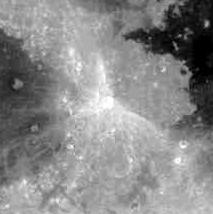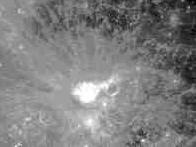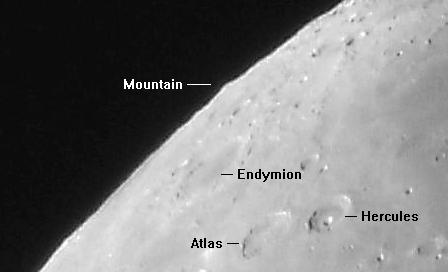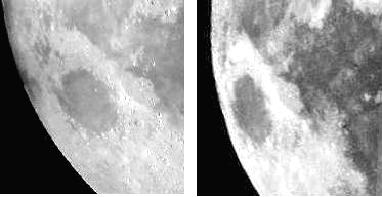Observing the Moon - Full Moon Sights
Jack Kramer
We've had a couple of articles in the newsletter about the many rays that are visible on the moon, especially around the full phase. Since every month we're beset with a full or nearly-full moon, it's worthwhile to add a couple of other features that also show up well during this phase. Here an object's ability to reflect light is far more important than its ability to throw a shadow. There simply aren't any shadows on a full moon! The fact that the sun is shining directly at the center of a full moon, eliminating any shadows, explains why it's about ten times as bright as a first quarter moon.
Rima Hyginus
"Rima" is the latin word for a rill, which is a long, winding gash or depression on the moon. Rima Hyginus is very close to the center of the moon as it faces toward us. While most rimae virtually disappear from view a day or so after lunar sunrise, Rima Hyginus gets brighter as the Sun rises, and is easily visible even during a full moon. One thing that contributes to its brightness is that it's fairly wide, with walls that are apparently slanted at just the right angle and composed of highly reflective regolith so as to reflect sunlight. The brightness may also be due to the fact that the floor of the Hyginus rill is peppered with small craters which may act as reflectors. Could this be a crater chain resulting when the incoming space debris tore apart prior to impact? The following image shows Rima Hyginus pretty much as it appears at full moon. (The first three images in this article are from the Clementine spacecraft.)

Bright Craters
Some craters become particularly prominent not because of the shadows they cast, but because of the sunlight they throw back across space toward our waiting telescopes. One of the most prominent craters during a full moon is Proclus, whose interior walls have a reflective power of 16%, which is unusually high for an object on the moon. It also sports two bright and unique rays that make it an unmistakable landmark (well, actually a moonmark). There's also an intricate, but much fainter, ray system extending into Mare Crisium. The following image shows bright Proclus and its "splash" pattern.

Of all the craters, the brightest during a full moon is Aristarchus, so bright in fact that it is said to be visible by naked eye. (But not by my naked eye!) It also has a small but complex ray system, which really appears as more of a "spray" pattern with one longer splash just skirting the neighboring crater Herodotus. Look for bright ejecta material abutting the southern edge of the crater. It seems as though the bright material from Aristarchus was thrown out within a fairly close range. The longer rays shown in the following photo are difficult to see through our scopes.

Limb Features
One bit of topography that stands out at just about any phase is the mountain peaks all around the lunar limb. These show up well because they are silhouetted against the blackness of space. The following image is one I took around first quarter; however, it does illustrate the limb topography as it would be seen at any phase. A particularly high mountain is noted, but the entire limb shows an uneven texture. Figuring out which details these are by name is often difficult because most lunar maps don't do a particularly good job of identifying features at the limb. But named or not, a view of these limb features reinforces the notion of the moon as another world.

The specific peaks that you will see at the limb are determined by the libration of the moon. Any time you gaze at the full moon, you're seeing 50% of its surface. While the moon always keeps the same face toward us, it's not exactly the same. Over a span of time, we actually end up seeing about 59% of the moon's surface - slightly beyond its poles and around the edge. We're seldom conscious of libration. However, in looking over my lunar images, I came across two that show the effect very well. Notice how in one image Mare Crisium appears much closer to the limb and is also more foreshortened. (The crater Proclus with its wide-spread rays also shows up brightly just to the right of Mare Crisium.) I took these images a couple of years apart, but the libration change occurs over an interval of about two weeks.

Libration in longitude results from the moon moving at slightly different speeds at different points in its orbit (in accord with Kepler's second law). Libration also occurs in latitude due to a slight tilt in the moon's axis.
Finally, a few words are in order about the use of a neutral density filter ("moon filter") to somewhat darken the image of a full moon as seen through your telescope. You might want to try it, though I've found more detail can be seen without a filter. Also, to examine many of these features, you'll want to use higher magnification, which tends to diffuse the bright light. The human eye adjusts pretty well to the increased brightness of the full moon. And let's face it, if you're observing the moon at this phase, your night vision will be just about shot anyhow!
Published in the September 2002 issue of the NightTimes




